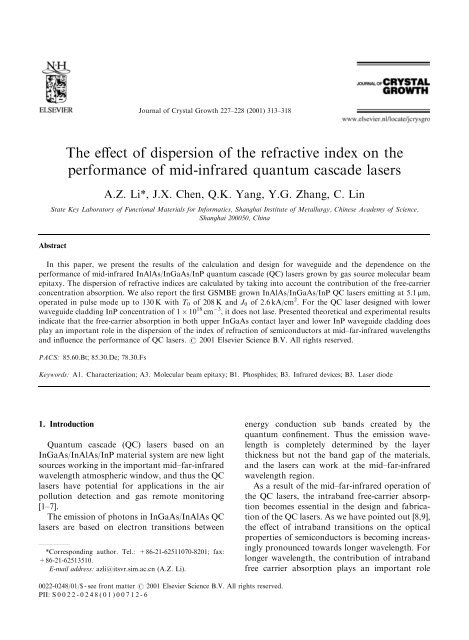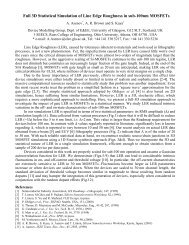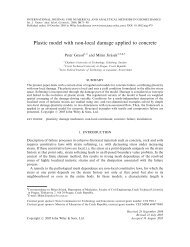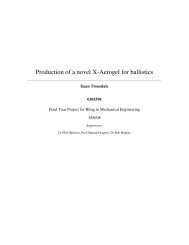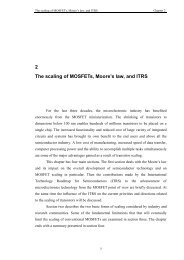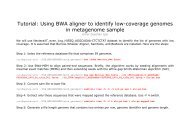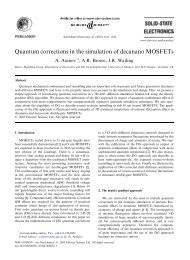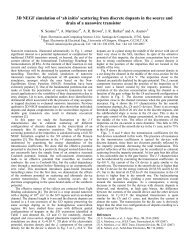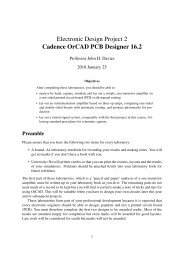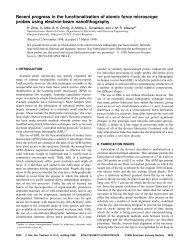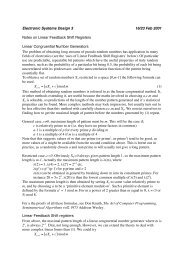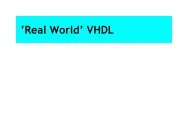The effect of dispersion of the refractive index on the performance of ...
The effect of dispersion of the refractive index on the performance of ...
The effect of dispersion of the refractive index on the performance of ...
You also want an ePaper? Increase the reach of your titles
YUMPU automatically turns print PDFs into web optimized ePapers that Google loves.
Journal <str<strong>on</strong>g>of</str<strong>on</strong>g> Crystal Growth 227–228 (2001) 313–318<br />
<str<strong>on</strong>g>The</str<strong>on</strong>g> <str<strong>on</strong>g>effect</str<strong>on</strong>g> <str<strong>on</strong>g>of</str<strong>on</strong>g> <str<strong>on</strong>g>dispersi<strong>on</strong></str<strong>on</strong>g> <str<strong>on</strong>g>of</str<strong>on</strong>g> <str<strong>on</strong>g>the</str<strong>on</strong>g> <str<strong>on</strong>g>refractive</str<strong>on</strong>g> <str<strong>on</strong>g>index</str<strong>on</strong>g> <strong>on</strong> <str<strong>on</strong>g>the</str<strong>on</strong>g><br />
<strong>performance</strong> <str<strong>on</strong>g>of</str<strong>on</strong>g> mid-infrared quantum cascade lasers<br />
A.Z. Li*, J.X. Chen, Q.K. Yang, Y.G. Zhang, C. Lin<br />
State Key Laboratory <str<strong>on</strong>g>of</str<strong>on</strong>g> Functi<strong>on</strong>al Materials for Informatics, Shanghai Institute <str<strong>on</strong>g>of</str<strong>on</strong>g> Metallurgy, Chinese Academy <str<strong>on</strong>g>of</str<strong>on</strong>g> Science,<br />
Shanghai 200050, China<br />
Abstract<br />
In this paper, we present <str<strong>on</strong>g>the</str<strong>on</strong>g> results <str<strong>on</strong>g>of</str<strong>on</strong>g> <str<strong>on</strong>g>the</str<strong>on</strong>g> calculati<strong>on</strong> and design for waveguide and <str<strong>on</strong>g>the</str<strong>on</strong>g> dependence <strong>on</strong> <str<strong>on</strong>g>the</str<strong>on</strong>g><br />
<strong>performance</strong> <str<strong>on</strong>g>of</str<strong>on</strong>g> mid-infrared InAlAs/InGaAs/InP quantum cascade (QC) lasers grown by gas source molecular beam<br />
epitaxy. <str<strong>on</strong>g>The</str<strong>on</strong>g> <str<strong>on</strong>g>dispersi<strong>on</strong></str<strong>on</strong>g> <str<strong>on</strong>g>of</str<strong>on</strong>g> <str<strong>on</strong>g>refractive</str<strong>on</strong>g> indices are calculated by taking into account <str<strong>on</strong>g>the</str<strong>on</strong>g> c<strong>on</strong>tributi<strong>on</strong> <str<strong>on</strong>g>of</str<strong>on</strong>g> <str<strong>on</strong>g>the</str<strong>on</strong>g> free-carrier<br />
c<strong>on</strong>centrati<strong>on</strong> absorpti<strong>on</strong>. We also report <str<strong>on</strong>g>the</str<strong>on</strong>g> first GSMBE grown InAlAs/InGaAs/InP QC lasers emitting at 5.1 mm,<br />
operated in pulse mode up to 130 K with T 0 <str<strong>on</strong>g>of</str<strong>on</strong>g> 208 K and J 0 <str<strong>on</strong>g>of</str<strong>on</strong>g> 2.6 kA/cm 2 . For <str<strong>on</strong>g>the</str<strong>on</strong>g> QC laser designed with lower<br />
waveguide cladding InP c<strong>on</strong>centrati<strong>on</strong> <str<strong>on</strong>g>of</str<strong>on</strong>g> 1 10 18 cm 3 , it does not lase. Presented <str<strong>on</strong>g>the</str<strong>on</strong>g>oretical and experimental results<br />
indicate that <str<strong>on</strong>g>the</str<strong>on</strong>g> free-carrier absorpti<strong>on</strong> in both upper InGaAs c<strong>on</strong>tact layer and lower InP waveguide cladding does<br />
play an important role in <str<strong>on</strong>g>the</str<strong>on</strong>g> <str<strong>on</strong>g>dispersi<strong>on</strong></str<strong>on</strong>g> <str<strong>on</strong>g>of</str<strong>on</strong>g> <str<strong>on</strong>g>the</str<strong>on</strong>g> <str<strong>on</strong>g>index</str<strong>on</strong>g> <str<strong>on</strong>g>of</str<strong>on</strong>g> refracti<strong>on</strong> <str<strong>on</strong>g>of</str<strong>on</strong>g> semic<strong>on</strong>ductors at mid–far-infrared wavelengths<br />
and influence <str<strong>on</strong>g>the</str<strong>on</strong>g> <strong>performance</strong> <str<strong>on</strong>g>of</str<strong>on</strong>g> QC lasers. # 2001 Elsevier Science B.V. All rights reserved.<br />
PACS: 85.60.Bt; 85.30.De; 78.30.Fs<br />
Keywords: A1. Characterizati<strong>on</strong>; A3. Molecular beam epitaxy; B1. Phosphides; B3. Infrared devices; B3. Laser diode<br />
1. Introducti<strong>on</strong><br />
Quantum cascade (QC) lasers based <strong>on</strong> an<br />
InGaAs/InAlAs/InP material system are new light<br />
sources working in <str<strong>on</strong>g>the</str<strong>on</strong>g> important mid–far-infrared<br />
wavelength atmospheric window, and thus <str<strong>on</strong>g>the</str<strong>on</strong>g> QC<br />
lasers have potential for applicati<strong>on</strong>s in <str<strong>on</strong>g>the</str<strong>on</strong>g> air<br />
polluti<strong>on</strong> detecti<strong>on</strong> and gas remote m<strong>on</strong>itoring<br />
[1–7].<br />
<str<strong>on</strong>g>The</str<strong>on</strong>g> emissi<strong>on</strong> <str<strong>on</strong>g>of</str<strong>on</strong>g> phot<strong>on</strong>s in InGaAs/InAlAs QC<br />
lasers are based <strong>on</strong> electr<strong>on</strong> transiti<strong>on</strong>s between<br />
*Corresp<strong>on</strong>ding author. Tel.: +86-21-62511070-8201; fax:<br />
+86-21-62513510.<br />
E-mail address: azli@itsvr.sim.ac.cn (A.Z. Li).<br />
energy c<strong>on</strong>ducti<strong>on</strong> sub bands created by <str<strong>on</strong>g>the</str<strong>on</strong>g><br />
quantum c<strong>on</strong>finement. Thus <str<strong>on</strong>g>the</str<strong>on</strong>g> emissi<strong>on</strong> wavelength<br />
is completely determined by <str<strong>on</strong>g>the</str<strong>on</strong>g> layer<br />
thickness but not <str<strong>on</strong>g>the</str<strong>on</strong>g> band gap <str<strong>on</strong>g>of</str<strong>on</strong>g> <str<strong>on</strong>g>the</str<strong>on</strong>g> materials,<br />
and <str<strong>on</strong>g>the</str<strong>on</strong>g> lasers can work at <str<strong>on</strong>g>the</str<strong>on</strong>g> mid–far-infrared<br />
wavelength regi<strong>on</strong>.<br />
As a result <str<strong>on</strong>g>of</str<strong>on</strong>g> <str<strong>on</strong>g>the</str<strong>on</strong>g> mid–far-infrared operati<strong>on</strong> <str<strong>on</strong>g>of</str<strong>on</strong>g><br />
<str<strong>on</strong>g>the</str<strong>on</strong>g> QC lasers, <str<strong>on</strong>g>the</str<strong>on</strong>g> intraband free-carrier absorpti<strong>on</strong><br />
becomes essential in <str<strong>on</strong>g>the</str<strong>on</strong>g> design and fabricati<strong>on</strong><br />
<str<strong>on</strong>g>of</str<strong>on</strong>g> <str<strong>on</strong>g>the</str<strong>on</strong>g> QC lasers. As we have pointed out [8,9],<br />
<str<strong>on</strong>g>the</str<strong>on</strong>g> <str<strong>on</strong>g>effect</str<strong>on</strong>g> <str<strong>on</strong>g>of</str<strong>on</strong>g> intraband transiti<strong>on</strong>s <strong>on</strong> <str<strong>on</strong>g>the</str<strong>on</strong>g> optical<br />
properties <str<strong>on</strong>g>of</str<strong>on</strong>g> semic<strong>on</strong>ductors is becoming increasingly<br />
pr<strong>on</strong>ounced towards l<strong>on</strong>ger wavelength. For<br />
l<strong>on</strong>ger wavelength, <str<strong>on</strong>g>the</str<strong>on</strong>g> c<strong>on</strong>tributi<strong>on</strong> <str<strong>on</strong>g>of</str<strong>on</strong>g> intraband<br />
free carrier absorpti<strong>on</strong> plays an important role<br />
0022-0248/01/$ - see fr<strong>on</strong>t matter # 2001 Elsevier Science B.V. All rights reserved.<br />
PII: S 0022-0248(01)00712-6
314<br />
A.Z. Li et al. / Journal <str<strong>on</strong>g>of</str<strong>on</strong>g> Crystal Growth 227–228 (2001) 313–318<br />
that cannot be ignored. This problem becomes<br />
essentially serious when <str<strong>on</strong>g>the</str<strong>on</strong>g> fundamental mode <str<strong>on</strong>g>of</str<strong>on</strong>g><br />
<str<strong>on</strong>g>the</str<strong>on</strong>g> waveguide couples with <str<strong>on</strong>g>the</str<strong>on</strong>g> high-loss plasm<strong>on</strong><br />
mode (approximates to a wavelength <str<strong>on</strong>g>of</str<strong>on</strong>g> 9.5 mm in<br />
<str<strong>on</strong>g>the</str<strong>on</strong>g> QC laser case) propagating al<strong>on</strong>g <str<strong>on</strong>g>the</str<strong>on</strong>g> metal<br />
c<strong>on</strong>tact-semic<strong>on</strong>ductor interface.<br />
<str<strong>on</strong>g>The</str<strong>on</strong>g> free carrier absorpti<strong>on</strong> in <str<strong>on</strong>g>the</str<strong>on</strong>g> substrate,<br />
which at <str<strong>on</strong>g>the</str<strong>on</strong>g> meantime serves as a lower waveguide<br />
in <str<strong>on</strong>g>the</str<strong>on</strong>g> QC lasers, have been experimentally shown<br />
to be a key feature <str<strong>on</strong>g>of</str<strong>on</strong>g> <str<strong>on</strong>g>the</str<strong>on</strong>g> QC lasers, especially for<br />
those working in <str<strong>on</strong>g>the</str<strong>on</strong>g> l<strong>on</strong>ger wavelength. When <str<strong>on</strong>g>the</str<strong>on</strong>g><br />
operati<strong>on</strong> wavelength gets l<strong>on</strong>ger, <str<strong>on</strong>g>the</str<strong>on</strong>g> doping<br />
c<strong>on</strong>centrati<strong>on</strong> in <str<strong>on</strong>g>the</str<strong>on</strong>g> substrate should be decreased,<br />
o<str<strong>on</strong>g>the</str<strong>on</strong>g>rwise <str<strong>on</strong>g>the</str<strong>on</strong>g> light output can be hardly obtained.<br />
<str<strong>on</strong>g>The</str<strong>on</strong>g> doping c<strong>on</strong>centrati<strong>on</strong> in <str<strong>on</strong>g>the</str<strong>on</strong>g> substrate has<br />
attracted remarkable attenti<strong>on</strong> during <str<strong>on</strong>g>the</str<strong>on</strong>g> past few<br />
years <strong>on</strong>ly because <str<strong>on</strong>g>the</str<strong>on</strong>g> problem is not essential for<br />
<str<strong>on</strong>g>the</str<strong>on</strong>g> traditi<strong>on</strong>al semic<strong>on</strong>ductor lasers, including <str<strong>on</strong>g>the</str<strong>on</strong>g><br />
heterojuncti<strong>on</strong> lasers and <str<strong>on</strong>g>the</str<strong>on</strong>g> multiple quantum<br />
well lasers.<br />
Although it has been experimentally dem<strong>on</strong>strated<br />
by ano<str<strong>on</strong>g>the</str<strong>on</strong>g>r group and our group that a farinfrared<br />
QC laser deserves a lowerly doped<br />
substrate than a mid-infrared QC laser does [1–<br />
7,10], <str<strong>on</strong>g>the</str<strong>on</strong>g>re is lack <str<strong>on</strong>g>of</str<strong>on</strong>g> systematically <str<strong>on</strong>g>the</str<strong>on</strong>g>oretical<br />
research <strong>on</strong> <str<strong>on</strong>g>the</str<strong>on</strong>g> <str<strong>on</strong>g>effect</str<strong>on</strong>g> <str<strong>on</strong>g>of</str<strong>on</strong>g> doping c<strong>on</strong>centrati<strong>on</strong> in<br />
<str<strong>on</strong>g>the</str<strong>on</strong>g> substrate <strong>on</strong> <str<strong>on</strong>g>the</str<strong>on</strong>g> behavior <str<strong>on</strong>g>of</str<strong>on</strong>g> QC lasers.<br />
<str<strong>on</strong>g>The</str<strong>on</strong>g>refore, in this paper, we present <str<strong>on</strong>g>the</str<strong>on</strong>g> results <str<strong>on</strong>g>of</str<strong>on</strong>g><br />
<str<strong>on</strong>g>the</str<strong>on</strong>g> calculati<strong>on</strong> and design for waveguide and <str<strong>on</strong>g>the</str<strong>on</strong>g><br />
dependence <strong>on</strong> <str<strong>on</strong>g>the</str<strong>on</strong>g> <strong>performance</strong> <str<strong>on</strong>g>of</str<strong>on</strong>g> mid-infrared<br />
InAlAs/InGaAs/InP quantum cascade lasers.<br />
2. <str<strong>on</strong>g>The</str<strong>on</strong>g>oretical results<br />
As we know, <str<strong>on</strong>g>the</str<strong>on</strong>g> realizati<strong>on</strong> <str<strong>on</strong>g>of</str<strong>on</strong>g> optical c<strong>on</strong>finement<br />
is acquired by <str<strong>on</strong>g>the</str<strong>on</strong>g> <str<strong>on</strong>g>refractive</str<strong>on</strong>g> <str<strong>on</strong>g>index</str<strong>on</strong>g> difference<br />
between <str<strong>on</strong>g>the</str<strong>on</strong>g> waveguide core and <str<strong>on</strong>g>the</str<strong>on</strong>g> waveguide<br />
claddings. Taking into account both <str<strong>on</strong>g>the</str<strong>on</strong>g> interband<br />
transiti<strong>on</strong>s and intraband transiti<strong>on</strong>s, which have<br />
been shown to yield results in excellent agreement<br />
with experiments, <str<strong>on</strong>g>the</str<strong>on</strong>g> <str<strong>on</strong>g>refractive</str<strong>on</strong>g> <str<strong>on</strong>g>index</str<strong>on</strong>g> nðoÞ can be<br />
expressed as [8,11]<br />
p<br />
nðoÞ ¼<br />
ffiffiffiffiffiffiffiffiffiffiffi<br />
e 1 ðoÞ ðho4E 0 Þ;<br />
ð1aÞ<br />
n<br />
o<br />
e 1 ðoÞ ¼A Fðx o Þþ0:5½E 0 =ðE 0 þ D 0 ÞŠ 3=2 Fðx os Þ<br />
þ B=ðhoÞ 2 þ C;<br />
ð1bÞ<br />
where e 1 ðoÞ is <str<strong>on</strong>g>the</str<strong>on</strong>g> real part <str<strong>on</strong>g>of</str<strong>on</strong>g> <str<strong>on</strong>g>the</str<strong>on</strong>g> complex<br />
dielectric c<strong>on</strong>stant, E 0 <str<strong>on</strong>g>the</str<strong>on</strong>g> bandgap, D 0 <str<strong>on</strong>g>the</str<strong>on</strong>g> spinorbit<br />
splitting energy, and <str<strong>on</strong>g>the</str<strong>on</strong>g> subscript os<br />
represents this term is brought by orbit-spin<br />
split-<str<strong>on</strong>g>of</str<strong>on</strong>g>f band absorpti<strong>on</strong>, where<br />
h pffiffiffiffiffiffiffiffiffiffiffi<br />
pffiffiffiffiffiffiffiffiffiffiffi<br />
i<br />
FðxÞ ¼x 2 2 1 þ x 1 xHðxÞ<br />
; ð2Þ<br />
x o ¼ ho ; x os ¼ ho<br />
ð3Þ<br />
E 0 E 0 þ D 0<br />
(<br />
1; x41<br />
HðxÞ ¼<br />
ð4Þ<br />
0; x > 1<br />
and A, B, C are parameters corresp<strong>on</strong>ding to <str<strong>on</strong>g>the</str<strong>on</strong>g><br />
strength parameters <str<strong>on</strong>g>of</str<strong>on</strong>g> <str<strong>on</strong>g>the</str<strong>on</strong>g> E 0 =ðE 0 þ D 0 Þ transiti<strong>on</strong>s,<br />
<str<strong>on</strong>g>the</str<strong>on</strong>g> free carrier absorpti<strong>on</strong>, and <str<strong>on</strong>g>the</str<strong>on</strong>g> n<strong>on</strong>dispersive<br />
c<strong>on</strong>tributi<strong>on</strong>s <str<strong>on</strong>g>of</str<strong>on</strong>g> <str<strong>on</strong>g>the</str<strong>on</strong>g> higher-lying band<br />
and <str<strong>on</strong>g>the</str<strong>on</strong>g> lattice, respectively.<br />
As being pointed out in Refs. [8,9,11], <str<strong>on</strong>g>the</str<strong>on</strong>g><br />
parameters A, B can be expressed as<br />
A ¼ 4 <br />
3 3=2<br />
3 2 m P 2 ; ð5aÞ<br />
B ¼ h 2 n e e 2<br />
;<br />
ð5bÞ<br />
m * e 0 e r<br />
where m is <str<strong>on</strong>g>the</str<strong>on</strong>g> combined density-<str<strong>on</strong>g>of</str<strong>on</strong>g>-states mass, P<br />
is <str<strong>on</strong>g>the</str<strong>on</strong>g> momentum matrix element, and n e is <str<strong>on</strong>g>the</str<strong>on</strong>g><br />
electr<strong>on</strong> c<strong>on</strong>centrati<strong>on</strong>, e 0 e r is <str<strong>on</strong>g>the</str<strong>on</strong>g> dielectric c<strong>on</strong>stant,<br />
and m * is <str<strong>on</strong>g>the</str<strong>on</strong>g> electr<strong>on</strong> <str<strong>on</strong>g>effect</str<strong>on</strong>g>ive mass. From<br />
Eq. (5b) <strong>on</strong>e knows that <str<strong>on</strong>g>the</str<strong>on</strong>g> electr<strong>on</strong> c<strong>on</strong>centrati<strong>on</strong><br />
affects <str<strong>on</strong>g>the</str<strong>on</strong>g> <str<strong>on</strong>g>refractive</str<strong>on</strong>g> <str<strong>on</strong>g>index</str<strong>on</strong>g> especially in <str<strong>on</strong>g>the</str<strong>on</strong>g> heavily<br />
doping case.<br />
Having a narrow bandgap, small <str<strong>on</strong>g>the</str<strong>on</strong>g>rmal<br />
resistivity, and easy to get an Ohmic c<strong>on</strong>tact,<br />
GaInAs is generally used as <str<strong>on</strong>g>the</str<strong>on</strong>g> c<strong>on</strong>tact layer for<br />
QC lasers. <str<strong>on</strong>g>The</str<strong>on</strong>g> <str<strong>on</strong>g>refractive</str<strong>on</strong>g> <str<strong>on</strong>g>index</str<strong>on</strong>g> versus wavelength<br />
for different materials and for GaInAs doped with<br />
different c<strong>on</strong>centrati<strong>on</strong>s are shown in Fig. 1. From<br />
Fig. 1, <strong>on</strong>e knows that for QC lasers working<br />
at l 9 mm, <str<strong>on</strong>g>the</str<strong>on</strong>g> doping c<strong>on</strong>centrati<strong>on</strong> n ¼ 1 <br />
10 19 cm 3 is required for <str<strong>on</strong>g>the</str<strong>on</strong>g> c<strong>on</strong>tact layer. While if<br />
l ¼ 5 mm, <str<strong>on</strong>g>the</str<strong>on</strong>g> doping c<strong>on</strong>centrati<strong>on</strong> n 1 10 20<br />
cm 3 is required for <str<strong>on</strong>g>the</str<strong>on</strong>g> c<strong>on</strong>tact layer.<br />
Using this kind <str<strong>on</strong>g>of</str<strong>on</strong>g> heavily doped c<strong>on</strong>tact layer,<br />
<str<strong>on</strong>g>the</str<strong>on</strong>g> coupling between <str<strong>on</strong>g>the</str<strong>on</strong>g> fundamental mode <str<strong>on</strong>g>of</str<strong>on</strong>g> <str<strong>on</strong>g>the</str<strong>on</strong>g><br />
waveguide and <str<strong>on</strong>g>the</str<strong>on</strong>g> high-loss plasm<strong>on</strong> mode<br />
propagating al<strong>on</strong>g <str<strong>on</strong>g>the</str<strong>on</strong>g> metal c<strong>on</strong>tact-semic<strong>on</strong>duc-
A.Z. Li et al. / Journal <str<strong>on</strong>g>of</str<strong>on</strong>g> Crystal Growth 227–228 (2001) 313–318 315<br />
tor interface can be <str<strong>on</strong>g>effect</str<strong>on</strong>g>ively suppressed, because<br />
<str<strong>on</strong>g>the</str<strong>on</strong>g> <str<strong>on</strong>g>refractive</str<strong>on</strong>g> <str<strong>on</strong>g>index</str<strong>on</strong>g> in <str<strong>on</strong>g>the</str<strong>on</strong>g> c<strong>on</strong>tact layer is so small.<br />
By solving <str<strong>on</strong>g>the</str<strong>on</strong>g> Maxwell’s equati<strong>on</strong>, we are able to<br />
get <str<strong>on</strong>g>the</str<strong>on</strong>g> mode distributi<strong>on</strong> for a QC laser. A<br />
schematic structure showing <str<strong>on</strong>g>the</str<strong>on</strong>g> waveguide <str<strong>on</strong>g>of</str<strong>on</strong>g> a<br />
quantum cascade laser working at l 8:5 mm is<br />
shown in Fig. 2.<br />
<str<strong>on</strong>g>The</str<strong>on</strong>g> free-carrier absorpti<strong>on</strong> can be obtained<br />
from <str<strong>on</strong>g>the</str<strong>on</strong>g> permittivity <str<strong>on</strong>g>of</str<strong>on</strong>g> semic<strong>on</strong>ductors,<br />
Fig. 1. (a) <str<strong>on</strong>g>The</str<strong>on</strong>g> <str<strong>on</strong>g>dispersi<strong>on</strong></str<strong>on</strong>g> <str<strong>on</strong>g>of</str<strong>on</strong>g> <str<strong>on</strong>g>refractive</str<strong>on</strong>g> <str<strong>on</strong>g>index</str<strong>on</strong>g> versus wavelength<br />
for GaInAs, AlInAs, and InP. <str<strong>on</strong>g>The</str<strong>on</strong>g> points in <str<strong>on</strong>g>the</str<strong>on</strong>g> lines are<br />
distincti<strong>on</strong> for different materials. (b) <str<strong>on</strong>g>The</str<strong>on</strong>g> relati<strong>on</strong>ship <str<strong>on</strong>g>of</str<strong>on</strong>g><br />
<str<strong>on</strong>g>refractive</str<strong>on</strong>g> <str<strong>on</strong>g>index</str<strong>on</strong>g> versus wavelength for GaInAs doped with<br />
different c<strong>on</strong>centrati<strong>on</strong>s.<br />
a ¼ oe 2<br />
n r c ;<br />
ð6Þ<br />
where e 2 is <str<strong>on</strong>g>the</str<strong>on</strong>g> imaginary part <str<strong>on</strong>g>of</str<strong>on</strong>g> <str<strong>on</strong>g>the</str<strong>on</strong>g> permittivity,<br />
n r is <str<strong>on</strong>g>the</str<strong>on</strong>g> <str<strong>on</strong>g>effect</str<strong>on</strong>g>ive refractivity, c is <str<strong>on</strong>g>the</str<strong>on</strong>g> speed <str<strong>on</strong>g>of</str<strong>on</strong>g> light<br />
in free space.<br />
Let us start with <str<strong>on</strong>g>the</str<strong>on</strong>g> semi-classical <str<strong>on</strong>g>the</str<strong>on</strong>g>ory <str<strong>on</strong>g>of</str<strong>on</strong>g><br />
dynamic electro-magnetic field. <str<strong>on</strong>g>The</str<strong>on</strong>g> behavior <str<strong>on</strong>g>of</str<strong>on</strong>g> a<br />
particle with mass m, charge e in an electricmagnetic<br />
field E 0 e iot (optical field) with a<br />
resistance g can be described by <str<strong>on</strong>g>the</str<strong>on</strong>g> equati<strong>on</strong>,<br />
m d2 x<br />
dt 2 þ mgdx dt þ mo2 0 x ¼ eE 0e iot ;<br />
ð7Þ<br />
where o 0 is <str<strong>on</strong>g>the</str<strong>on</strong>g> intrinsic frequency <str<strong>on</strong>g>of</str<strong>on</strong>g> <str<strong>on</strong>g>the</str<strong>on</strong>g> particle.<br />
When we are interested in <str<strong>on</strong>g>the</str<strong>on</strong>g> behavior <str<strong>on</strong>g>of</str<strong>on</strong>g> <str<strong>on</strong>g>the</str<strong>on</strong>g> free<br />
carriers around <str<strong>on</strong>g>the</str<strong>on</strong>g> optical frequency, <str<strong>on</strong>g>the</str<strong>on</strong>g> last term<br />
in <str<strong>on</strong>g>the</str<strong>on</strong>g> left side <strong>on</strong> Eq. (7) can be neglected, with m<br />
being substituted by an <str<strong>on</strong>g>effect</str<strong>on</strong>g>ive mass m * . One<br />
Fig. 2. Schematic structure with InP buffer layer <str<strong>on</strong>g>of</str<strong>on</strong>g> a quantum cascade laser working at l 8:0 mm.
316<br />
A.Z. Li et al. / Journal <str<strong>on</strong>g>of</str<strong>on</strong>g> Crystal Growth 227–228 (2001) 313–318<br />
gets<br />
If we are interested in <str<strong>on</strong>g>the</str<strong>on</strong>g> mid–far-infrared<br />
m * d2 x<br />
dt 2 þ m * g dx<br />
wavelength, l 6 mm, we have o 0:5 10 14 Hz,<br />
dt ¼ eE 0e iot :<br />
ð8Þ and ðotÞ 2 2500. Thus we get<br />
Solving this equati<strong>on</strong>, <strong>on</strong>e gets<br />
aðoÞ 4pn 0e 2 1 1<br />
x ¼<br />
eE 0e iot<br />
n<br />
1<br />
r m * c o 2 t<br />
m * o 2 þ iog :<br />
ð9Þ<br />
¼ 4pn 0e 2 1<br />
Under <str<strong>on</strong>g>the</str<strong>on</strong>g> dipole approximati<strong>on</strong>, <str<strong>on</strong>g>the</str<strong>on</strong>g> polarizati<strong>on</strong> n r m * c l2 t ;<br />
ð16Þ<br />
is<br />
where l is <str<strong>on</strong>g>the</str<strong>on</strong>g> emissi<strong>on</strong> wavelength.<br />
P ¼ n 0 ex;<br />
ð10Þ Eq. (16) shows that in <str<strong>on</strong>g>the</str<strong>on</strong>g> mid–far-infrared<br />
where n 0 is <str<strong>on</strong>g>the</str<strong>on</strong>g> number <str<strong>on</strong>g>of</str<strong>on</strong>g> electr<strong>on</strong>s per unit volume,<br />
i.e. <str<strong>on</strong>g>the</str<strong>on</strong>g> doping c<strong>on</strong>centrati<strong>on</strong> in <str<strong>on</strong>g>the</str<strong>on</strong>g> substrate (1) proporti<strong>on</strong>al to <str<strong>on</strong>g>the</str<strong>on</strong>g> doping c<strong>on</strong>centrati<strong>on</strong>, and<br />
wavelength range, <str<strong>on</strong>g>the</str<strong>on</strong>g> free-carrier absorpti<strong>on</strong> is<br />
for <str<strong>on</strong>g>the</str<strong>on</strong>g> problem we are discussing. <str<strong>on</strong>g>The</str<strong>on</strong>g>refore, <str<strong>on</strong>g>the</str<strong>on</strong>g> (2) proporti<strong>on</strong>al to <str<strong>on</strong>g>the</str<strong>on</strong>g> square <str<strong>on</strong>g>of</str<strong>on</strong>g> <str<strong>on</strong>g>the</str<strong>on</strong>g> wavelength.<br />
polarizati<strong>on</strong> ratio Z can be expressed as:<br />
When <str<strong>on</strong>g>the</str<strong>on</strong>g> emissi<strong>on</strong> wavelength in QC lasers gets<br />
P<br />
Z ¼<br />
eE 0 e iot ¼ n 0e 2<br />
l<strong>on</strong>ger, <str<strong>on</strong>g>the</str<strong>on</strong>g> doping c<strong>on</strong>centrati<strong>on</strong> in <str<strong>on</strong>g>the</str<strong>on</strong>g> substrate<br />
1<br />
m * o 2 ð11Þ (<str<strong>on</strong>g>the</str<strong>on</strong>g> lower waveguide) should be decreased, in<br />
þ iog<br />
order to lower <str<strong>on</strong>g>the</str<strong>on</strong>g> free-carrier absorpti<strong>on</strong>; or a<br />
and <str<strong>on</strong>g>the</str<strong>on</strong>g> permittivity<br />
lowly doped buffer layer should be inserted<br />
4pn 0 e 2 1<br />
between <str<strong>on</strong>g>the</str<strong>on</strong>g> substrate and <str<strong>on</strong>g>the</str<strong>on</strong>g> active regi<strong>on</strong>.<br />
eðoÞ ¼1 þ 4pZ ¼ 1<br />
m * o 2 þ iog : ð12Þ<br />
We can get <str<strong>on</strong>g>the</str<strong>on</strong>g> real part and <str<strong>on</strong>g>the</str<strong>on</strong>g> imaginary part <str<strong>on</strong>g>of</str<strong>on</strong>g> 3. Experimental results<br />
<str<strong>on</strong>g>the</str<strong>on</strong>g> permittivity:<br />
4pn 0 e 2 1<br />
e 1 ðoÞ ¼1<br />
m * o 2 þ g 2;<br />
ð13aÞ <str<strong>on</strong>g>The</str<strong>on</strong>g> wafers were grown <strong>on</strong> (0 0 1) oriented S-<br />
doped InP substrates with a VG Semic<strong>on</strong> V80 H<br />
e 2 ðoÞ ¼ 4pn gas source molecular beam epitaxy system [10,12].<br />
0e 2 g<br />
m * oðo 2 þ g 2 Þ :<br />
ð13bÞ <str<strong>on</strong>g>The</str<strong>on</strong>g> growth temperature was 5208C. During <str<strong>on</strong>g>the</str<strong>on</strong>g><br />
growth <str<strong>on</strong>g>of</str<strong>on</strong>g> <str<strong>on</strong>g>the</str<strong>on</strong>g> AlInAs/GaInAs heterostructure,<br />
Thus <str<strong>on</strong>g>the</str<strong>on</strong>g> free carrier absorpti<strong>on</strong><br />
<str<strong>on</strong>g>the</str<strong>on</strong>g> Ga shutter switched <strong>on</strong> at <str<strong>on</strong>g>the</str<strong>on</strong>g> same time when<br />
aðoÞ ¼ oe <str<strong>on</strong>g>the</str<strong>on</strong>g> Al shutter switched <str<strong>on</strong>g>of</str<strong>on</strong>g>f, no interrupti<strong>on</strong> has<br />
2ðoÞ<br />
been adopted during <str<strong>on</strong>g>the</str<strong>on</strong>g> growth <str<strong>on</strong>g>of</str<strong>on</strong>g> <str<strong>on</strong>g>the</str<strong>on</strong>g> multiplequantum<br />
wells.<br />
n r c<br />
¼ o<br />
n r c 4pn 0e 2 g<br />
<str<strong>on</strong>g>The</str<strong>on</strong>g> parameters for all samples were preadjusted<br />
with single epilayers and checked by<br />
m * oðo 2 þ g 2 Þ<br />
reflecti<strong>on</strong> high-energy electr<strong>on</strong> diffracti<strong>on</strong><br />
¼ 4pn 0e 2 g<br />
n r m * c o 2 þ g 2:<br />
ð14Þ (RHEED), high-resoluti<strong>on</strong> XRD, and high-resoluti<strong>on</strong><br />
simulati<strong>on</strong> based <strong>on</strong> dynamical <str<strong>on</strong>g>the</str<strong>on</strong>g>ory <str<strong>on</strong>g>of</str<strong>on</strong>g><br />
XRD. <str<strong>on</strong>g>The</str<strong>on</strong>g> growth rate was determined by optical<br />
<str<strong>on</strong>g>The</str<strong>on</strong>g> resistance factor g can be approximately<br />
microscopy to be 1.50 mm per hour. <str<strong>on</strong>g>The</str<strong>on</strong>g> lattice<br />
obtained by <str<strong>on</strong>g>the</str<strong>on</strong>g> intraband relaxati<strong>on</strong> time (ph<strong>on</strong><strong>on</strong><br />
mismatch between epilayers and substrates was<br />
assisted relaxati<strong>on</strong> time) with <str<strong>on</strong>g>the</str<strong>on</strong>g> relati<strong>on</strong> ship:<br />
c<strong>on</strong>trolled to be no more than 8 10 4 .<br />
gt ¼ 1<br />
<str<strong>on</strong>g>The</str<strong>on</strong>g> X-ray diffracti<strong>on</strong> was performed <strong>on</strong> a<br />
and <str<strong>on</strong>g>the</str<strong>on</strong>g> intraband relaxati<strong>on</strong> time t1 ps. <str<strong>on</strong>g>The</str<strong>on</strong>g>refore<br />
Eq. (14) can be rewritten as<br />
folded Ge (2 2 0) m<strong>on</strong>ochromator and a resoluti<strong>on</strong><br />
Philips X’Pert MRD system, which had a four-<br />
aðoÞ ¼ 4pn 0e 2<br />
<str<strong>on</strong>g>of</str<strong>on</strong>g> 12 arcsec. During <str<strong>on</strong>g>the</str<strong>on</strong>g> measurements, <str<strong>on</strong>g>the</str<strong>on</strong>g> signalto-noise<br />
ratio was c<strong>on</strong>trolled to be 2 10 4 . <str<strong>on</strong>g>The</str<strong>on</strong>g><br />
1 1 1<br />
n r m * c o 2 t 1 þ 1=o 2 t 2: ð15Þ optical measurements were performed <strong>on</strong> a Nicolet
A.Z. Li et al. / Journal <str<strong>on</strong>g>of</str<strong>on</strong>g> Crystal Growth 227–228 (2001) 313–318 317<br />
driven by pulsed current under various heat-sink<br />
temperatures.<br />
C<strong>on</strong>sidering <str<strong>on</strong>g>the</str<strong>on</strong>g> free-carrier absorpti<strong>on</strong> in <str<strong>on</strong>g>the</str<strong>on</strong>g><br />
mid–far-infrared wavelength range, we grew different<br />
doping c<strong>on</strong>centrati<strong>on</strong> <str<strong>on</strong>g>of</str<strong>on</strong>g> 1 10 17 ,5 10 17<br />
and 1 10 18 cm 3 for InP lower waveguide cladding.<br />
Figs. 3 and 4 show <str<strong>on</strong>g>the</str<strong>on</strong>g> pulse emissi<strong>on</strong> spectra<br />
and <str<strong>on</strong>g>the</str<strong>on</strong>g> dependence <str<strong>on</strong>g>of</str<strong>on</strong>g> threshold current density<br />
<strong>on</strong> <str<strong>on</strong>g>the</str<strong>on</strong>g> operating temperature. For a QC laser<br />
operating at 8.2 mm with lower waveguide cladding<br />
InP c<strong>on</strong>centrati<strong>on</strong> <str<strong>on</strong>g>of</str<strong>on</strong>g> 2 10 17 cm 3 , for a QC laser<br />
working at 5.1 mm with lower waveguide cladding<br />
InP c<strong>on</strong>centrati<strong>on</strong> <str<strong>on</strong>g>of</str<strong>on</strong>g> 5 10 17 cm 3 . As we previously<br />
dem<strong>on</strong>strated, our <strong>on</strong>e-step GSMBE<br />
Fig. 3. Pulse emissi<strong>on</strong> spectra at several temperatures for a<br />
quantum cascade laser <str<strong>on</strong>g>of</str<strong>on</strong>g> 2 mm length and 12 mm width. (a) For<br />
5 mm QC lasers with lower waveguide cladding InP c<strong>on</strong>centrati<strong>on</strong><br />
<str<strong>on</strong>g>of</str<strong>on</strong>g> 5 10 17 cm 3 . (b) For 8 mm QC lasers with lower<br />
waveguide cladding InP c<strong>on</strong>centrati<strong>on</strong> <str<strong>on</strong>g>of</str<strong>on</strong>g> 2 10 17 cm 3 .<br />
760 Fourier transform infrared spectrometer with<br />
an Ar i<strong>on</strong> (514.5 nm) laser as <str<strong>on</strong>g>the</str<strong>on</strong>g> excitati<strong>on</strong> source<br />
and a liquid-nitrogen cooled InSb detector for<br />
receiving signal.<br />
<str<strong>on</strong>g>The</str<strong>on</strong>g> laser samples were processed into mesa<br />
etched ridge waveguides <str<strong>on</strong>g>of</str<strong>on</strong>g> width 8–14 mm. <str<strong>on</strong>g>The</str<strong>on</strong>g><br />
lasers were cleaved into 2 mm l<strong>on</strong>g bard and <str<strong>on</strong>g>the</str<strong>on</strong>g><br />
facets were left uncoated. <str<strong>on</strong>g>The</str<strong>on</strong>g> lasers were <str<strong>on</strong>g>the</str<strong>on</strong>g>n<br />
Fig. 4. Experimental plot threshold current density versus<br />
temperature for 2 mm cavity length QC lasers. (a) 5 mm QCL.<br />
(b) 8 mm QCL.
318<br />
A.Z. Li et al. / Journal <str<strong>on</strong>g>of</str<strong>on</strong>g> Crystal Growth 227–228 (2001) 313–318<br />
grown QC lasers emitting at 8.16 mm. from Figs. 3<br />
and 4 we can see <str<strong>on</strong>g>the</str<strong>on</strong>g> 8.16 mm lasers operating at<br />
250 K and with a characteristic temperature (T 0 )<br />
<str<strong>on</strong>g>of</str<strong>on</strong>g> 229 K and a J 0 <str<strong>on</strong>g>of</str<strong>on</strong>g> 1.27 KA/cm 2 . In this paper,<br />
we report <str<strong>on</strong>g>the</str<strong>on</strong>g> first <strong>on</strong>e-step GSMBE grown<br />
InAlAs/InGaAs/InP QC lasers emitting at<br />
5.1 mm, operated in pulse mode up to 130 K with<br />
T 0 <str<strong>on</strong>g>of</str<strong>on</strong>g> 208 K and J 0 <str<strong>on</strong>g>of</str<strong>on</strong>g> 2.6 KA/cm 2 . For <str<strong>on</strong>g>the</str<strong>on</strong>g> QC<br />
laser designed with lower waveguide cladding InP<br />
c<strong>on</strong>centrati<strong>on</strong> <str<strong>on</strong>g>of</str<strong>on</strong>g> 1 10 18 cm 3 , it does not lase.<br />
4. C<strong>on</strong>clusi<strong>on</strong><br />
In summary, we have presented <str<strong>on</strong>g>the</str<strong>on</strong>g>oretical and<br />
experimental results <strong>on</strong> <str<strong>on</strong>g>the</str<strong>on</strong>g> <str<strong>on</strong>g>effect</str<strong>on</strong>g> <str<strong>on</strong>g>of</str<strong>on</strong>g> <str<strong>on</strong>g>dispersi<strong>on</strong></str<strong>on</strong>g> <str<strong>on</strong>g>of</str<strong>on</strong>g><br />
<str<strong>on</strong>g>the</str<strong>on</strong>g> <str<strong>on</strong>g>refractive</str<strong>on</strong>g> <str<strong>on</strong>g>index</str<strong>on</strong>g> <strong>on</strong> <str<strong>on</strong>g>the</str<strong>on</strong>g> <strong>performance</strong> <str<strong>on</strong>g>of</str<strong>on</strong>g> midinfrared<br />
quantum cascade lasers. <str<strong>on</strong>g>The</str<strong>on</strong>g> results<br />
indicate that <str<strong>on</strong>g>the</str<strong>on</strong>g> free-carrier absorpti<strong>on</strong> in both<br />
upper InGaAs c<strong>on</strong>tact layer and lower InP<br />
waveguide cladding does play an important role<br />
in <str<strong>on</strong>g>the</str<strong>on</strong>g> <str<strong>on</strong>g>dispersi<strong>on</strong></str<strong>on</strong>g> <str<strong>on</strong>g>of</str<strong>on</strong>g> <str<strong>on</strong>g>the</str<strong>on</strong>g> <str<strong>on</strong>g>index</str<strong>on</strong>g> <str<strong>on</strong>g>of</str<strong>on</strong>g> refracti<strong>on</strong> <str<strong>on</strong>g>of</str<strong>on</strong>g><br />
semic<strong>on</strong>ductors at mid–far-infrared wavelengths<br />
and influence <str<strong>on</strong>g>the</str<strong>on</strong>g> <strong>performance</strong> <str<strong>on</strong>g>of</str<strong>on</strong>g> QC lasers. It<br />
must <str<strong>on</strong>g>the</str<strong>on</strong>g>refore taken into account in order to<br />
properly interpret <str<strong>on</strong>g>the</str<strong>on</strong>g> <str<strong>on</strong>g>dispersi<strong>on</strong></str<strong>on</strong>g> <str<strong>on</strong>g>of</str<strong>on</strong>g> <str<strong>on</strong>g>the</str<strong>on</strong>g> <str<strong>on</strong>g>refractive</str<strong>on</strong>g><br />
<str<strong>on</strong>g>index</str<strong>on</strong>g> over this range <str<strong>on</strong>g>of</str<strong>on</strong>g> wavelengths.<br />
References<br />
[1] J. Faist, F. Capasso, D.L. Sivco, C. Sirtori, A.L.<br />
Hutchins<strong>on</strong>, A.Y. Cho, Science 264 (1994) 553.<br />
[2] G. Scamarcio, F. Capasso, C. Sirtori, J. Faist, A.L.<br />
Hutchins<strong>on</strong>, D.L. Sivco, A.Y. Cho, Science 276 (1997)<br />
5313.<br />
[3] J. Faist, F. Capasso, C. Sirtori, D.L. Sivco, A.L.<br />
Hutchins<strong>on</strong>, A.Y. Cho, Nature 387 (1997) 777.<br />
[4] C. Gmachl, A. Tredicucci, D.L. Sivco, A.L. Hutchins<strong>on</strong>,<br />
F. Capasso, A.Y. Cho, Science 286 (1999) 749.<br />
[5] G. Scamarcio, F. Capasso, C. Sirtori, D.L. Sivco, A.L.<br />
Hutchins<strong>on</strong>, A.Y. Cho, Science 276 (1997) 773.<br />
[6] S. Slivken, C. Jelen, A. Rybaltowski, J. Diaz, M. Razeghi,<br />
Appl. Phys. Lett. 71 (1997) 2593.<br />
[7] C. Gmachl, A. Tredicucci, F. Capasso, A.L. Hutchins<strong>on</strong>,<br />
D.L. Sivco, J.N. Bailarge<strong>on</strong>, A.Y. Cho, Appl. Phys. Lett.,<br />
72 (1998) 3130.<br />
[8] W.G. Bi, A.Z. Li, J. Appl. Phys. 71 (1992) 2826.<br />
[9] Q.K. Yang, A.Z. Li, Chin. Phys. Lett. 16 (1999) 610.<br />
[10] A.Z. Li, J.X. Chen, Q.K. Yang, C. Lin, Y.C. Ren, J. Cryst.<br />
Growth 201/202 (1999) 901.<br />
[11] S. Adachi, J. Appl. Phys. 53 (1982) 5863.<br />
[12] Q.K. Yang, J.X. Chen, A.Z. Li, J. Crystal Growth 209<br />
(2000) 8.<br />
Acknowledgements<br />
This work is supported in part by <str<strong>on</strong>g>the</str<strong>on</strong>g> Chinese<br />
Academy <str<strong>on</strong>g>of</str<strong>on</strong>g> Sciences under C<strong>on</strong>tract No. KJ951-<br />
B1-706-01.


